Waste Reduction
I've been thinking a lot about trash lately. In part because it's almost time for our annual Christmas dumpster (to be delayed this year until after the holidays, due to schedule conflicts and the fact that we have a trillion other things to get done before Christmas without adding a dumpster to the mix). But in part because trash is one of those things I think we don't think about enough. You throw something away, and a guy comes and takes it. Where does it go? A landfill. But what happens to it there? It just sits in layer upon layer of stuff.
I just think we should be more conscious about stuff, and why we bring it into our lives. What if everything you brought home was wanted and needed and used up when you were done with it?
So I thought I'd take you on a guided tour of how things come into and go out of our house. I think it'd be useful to see or hear what other people are doing with what they buy (and especially the packaging it comes in). This time of the year there seems to be a lot more trash in our household, and it's a constant battle to keep it down.
Reducing Trash/Reusable Containers
The best way to reduce the amount of waste you produce is to not bring the stuff that is waste into the house to begin with. We've been making a real effort to cut this stuff out, both by not buying things we might have in the past because they have too much packaging, and by being more honest about the expected life of an object we're thinking about buying.
Because we eat relatively little packaged food, the majority of our non-construction waste last year was plastic bags from shopping excursions. So for us, the easiest way to reduce our trash/recycling load was to stop bringing plastic bags into the house. We've taken a few steps to reduce the number of shopping bags we end up with, beyond just carrying stuff out of stores with no bag.
1. Canvas bags and a grocery basket
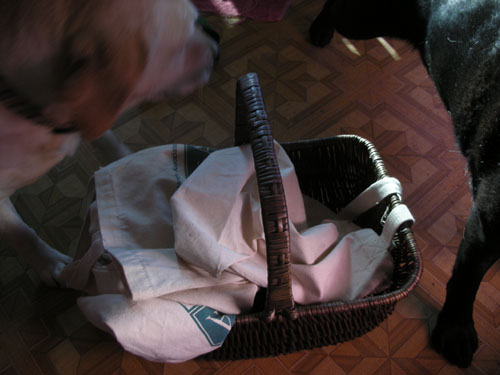
My parents gave us several canvas bags from library conferences, extras from their household's stash, plus we have a super-pretty fold-up bag the in-laws gave us, and a couple other bags from conferences, events, and so on. We take them to the grocery store, obviously, but they also work for other stores, like the pet food store or the bookstore, or the hardware store. I find it works best to keep them in the car that we use most often for errands, because otherwise the spontaneous "what do we need to get while we are out" trips become big waste-generators. A couple of years ago people thought we were insane to use reusable bags, but now you see far more acceptance of the idea in many more stores.
I got the basket while I was in school in San Luis Obispo. I can fit a small grocery run in there easily, and things don't get crushed the way they do in bags. Also, it meant I wouldn't buy more than I could carry. Very handy. We don't do farmer's markets very often, but the basket helps with harvesting from the garden, too.
2. Weekly vegetable CSA
We get a box of fruit and vegetables weekly from Eatwell Farm, which comes in moderate packaging. Unlike going to the store or a market for produce, we don't end up with a lot of plastic bags; the veggies that are wrapped up come in either paper bags (reusable as lunch bags) or plastic for the things that need it, and they all come in this reusable box that we take back to the dropoff location every week. Additional wrappings are usually paper bags (greens come in plastic, so that's not 100 percent worked out).
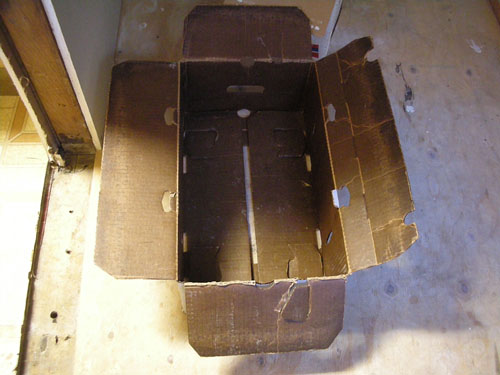
The CSA also keeps us from buying a lot of packaged foods, which former roommate John was very fond of. Packaged foods are packaged, and generate a lot of trash. Most of it is recyclable, but it's notable that since John moved out, we can once again skip a couple weeks of trash pickup without it turning into a massive household problem. And since we are both forgetful and lazy, this is a good thing. No more early morning dashes to the curb in pajamas and robe. Not eating so much packaged food is a major part of our waste-reduction strategy, and it turns out it's better for you, and the food tastes better, too.
3. Monthly meat CSA
We don't eat a lot of meat, so the packaging that meat comes in is not a massive problem, but I hate those foam trays. This summer we joined Marin Sun Farms' monthly meat club, and now we never buy meat at the store (for the most part because it turns out we don't eat nearly as much meat as we thought, and the meat club fills all our needs and more). Once a month a box of frozen meats arrives at our pickup location. The meat is wrapped in plastic, but no foam. At this point I can't see how we can eliminate plastic completely, but I think we've gotten the food waste down as much as we can without dramatically changing our diet. The best part of the deal, of course, is that the meat is ethically raised and slaughtered, so we aren't eating sorrow. It tastes a lot better than grocery store meat, too.
4. Rethinking junk
I'm guilty of buying things I think are funny, which basically just become trash. Joke gifts and odd little vending-machine toys can really junk a place up, and do I really need that? These days, I'm admitting that I really don't. Making a real effort to be a conscientious consumer is hard work, but it has its rewards. Aside from a cleaner, less junky house, there's also the knowledge that you will not be throwing away that item in six months, when it breaks or just loses amusement value.
5. E-books
The number one thing I spend money on is books. This is also the single largest category of stuff in our house, and please bear in mind that Noel has a number of musical instruments including a two pianos (one a grand) and a small pump organ. So we have a LOT of books.
This is not a vice, really, but there are some books that I have to replace regularly (professional references) and of those, many are available as e-books, and of those, most are provided to me for free by my firm (as opposed to the paper books, which I would have had to buy for myself). This summer I bought an Iliad e-book reader, and I have started collecting references on it. Many things I used to have to print out can now be neatly kept on the Iliad in a relatively small space. The screen is clear and easy to read, not quite but almost as contrasty as paper. It lives nearly forever on a battery charge. You can make notes on the pages that are 100 percent erasable.
The bonus is that I can carry what used to be 300 lbs of books to and from work with me every day. I haven't yet begun buying things like paperback novels on the Iliad, but I'm tempted. The price is not quite where I want it to be for back-catalog titles, but that will be here soon enough. If you're a voracious reader, rather than a book fetishist (and I'm some of both), e-books are a great way to reduce the amount of stuff in your house.
Un-Trashing
The next step, after reducing what we bring home, is to "use all parts of the elephant," as it were. Instead of throwing things away when we don't need them for their primary purpose, we find other purposes for them, other ways to use them apart from as trash-bag fillers.
The biggest way we reduce our trash stream is to use waste in the garden. We compost as much as possible, which is everything from food-soiled paper to shredded bills to dog poop. We get a large green bin for yard waste and food waste from the city, but we almost never use it. Sometimes a neighbor borrows it to handle extra prunings, but we also take compostables from our neighbors to augment our piles.
Here's some of our composting setup:
With two large dogs, a major source of waste is dog poop, which we compost in a pit. We dig these pits around ornamental plants, fill them up with poop and then cover them over and dig a new pit. Within a year, the old pit is completely finished off, and the soil is improved by the organic matter.
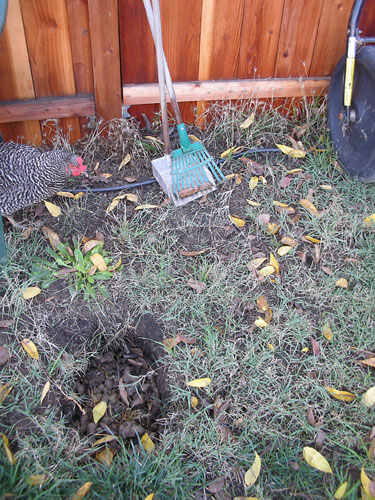
Initially I built a dog poop digester, and was trying to operate that in one location more or less permanently, but I found it didn't meet my need to not just eliminate the dog poop but to actually use it. A digester will make one very fertile area in the garden. The pits make lots and lots. This has completely eliminated one really nasty, smelly form of trash that we hated dealing with, and added a new source of organic matter for the garden, which costs money in other forms. Our Cecile Brunner rose loves the dog poop.
I realize this is not how most people feel, but it used to just kill me to send perfectly fine organic material (well, poop) to a landfill, wrapped in several layers of plastic (and it especially killed me that we bought plastic bags to use to throw it away). Now we don't buy that plastic, and we get to use the poop to make a beautiful garden. Win-win.
Our main composting setup is large and getting larger. We have a series of composters in the chicken yard, and one barrel composter outside the chicken yard. Yard waste goes into the most recent pile and gets mixed with food waste, soiled chicken bedding, and raked-up chicken poops from the chicken yard. We're now batch composting in the barrel, which we fill up with whatever is on the regular piles and beat into a nice finished compost. The barrel composter is closed enough that we can put meat waste in it, too, which is a major bonus. I'm not finding that it produces finished compost in the promised 21-day timeline, but just having a place to compost previously uncompostable things makes up for that.
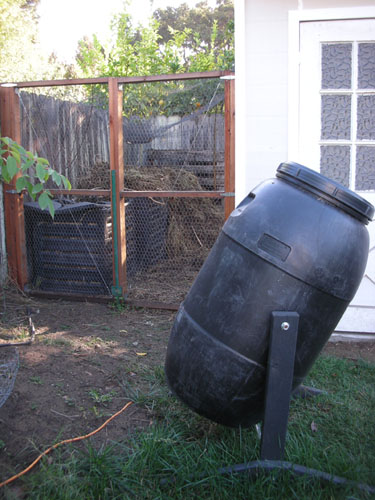
An important part of our composting setup is the compost processing crew. The chickens spend much of their day in the compost piles, scratching, tearing things apart, adding nitrogen-rich fresh chicken poop, and turning the piles slowly. I can't say they're essential to a composting setup, but it does help to have the chickens to do primary processing on the kitchen garbage and garden trimmings.
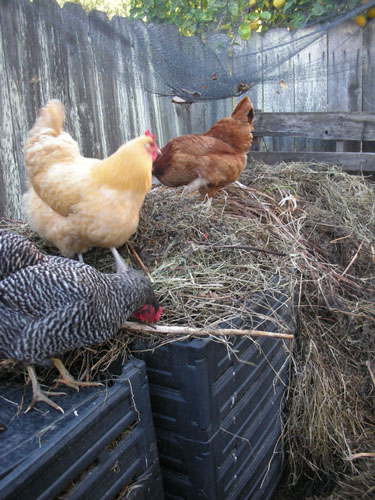
Inside the house, we have the worm bin. I should say that the worm composting has been the hardest project we've done, composting-wise. We have overfilled the bin, nearly killed all our worms, made some really horrific smells, and generally had a really rough time with getting the worms to work for us. Not that this is impossible, but it's definitely not nearly as easy as just composting our food waste is. We got some good advice and are back on track, but I'm no longer recommending worm bins for beginners to composting.
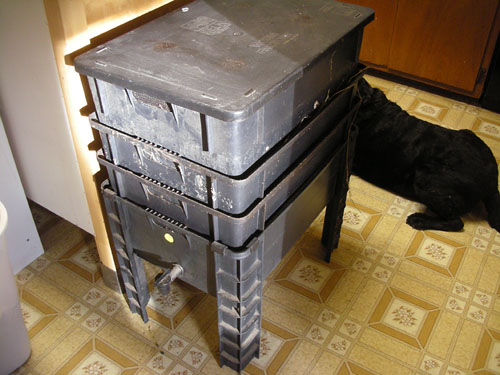
Key to composting is having a place where you collect the things to compost. For us it's this old pot (the non-stick coating is coming off so it was no longer useful for cooking; I'm thinking of sandblasting it remove it altogether). We collect some trash there, then it goes to the outside piles, the barrel composter, or the worms. I don't like a covered container because I think it tends to let you accumulate things until the container gets really gross.
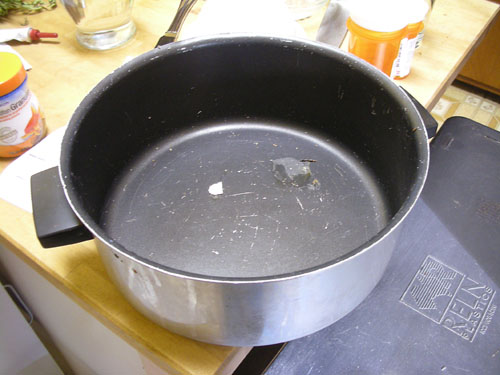
And last of all, our last-resort compost solution is burning. We end up with a lot of little ends of wood from construction projects, too small to be useful but too large to compost effectively (I've tried, believe me). So we bought this little brazier (I guess everybody calls them "fire pits" now, but it's not a pit). Start a little fire, burn the wood down, and then put the ash in the compost to amend it.
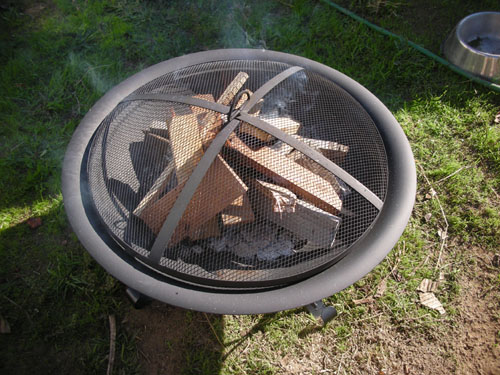
Burning is super bad for the atmosphere (smoke is a greenhouse gas), but the "coals" -- the burnt pieces of wood -- hold nutrients in the soil and contribute to my own little Terra Preta experiment.
Giving Away
We maintain a large pile of stuff that we no longer need or want, to give away to friends (who rifle through the pile and take what they want), Goodwill (for our regular donation run), and used bookstores (where they get traded for other books).
As an aside, I made a used bookstore run recently and this is not a good time to be selling books, but it is an awesome time to be buying.
I find it easier to get rid of stuff when it's going to somebody who will use it, rather than in a trash can. Especially clothes that don't fit right after a few washings, or pieces of furniture that we have replaced with something nicer. When I moved back from school, we had to go through the combined households exercise a second time, and we ended up with a huge pile of things to put in the giveaway pile.
Recycling
The very last thing to do to divert waste from the trash is recycling it. I'm not a fan of recycling. Don't get me wrong: I'm completely opposed to throwing things in a landfill if avoidable, but recycling is just about the same. Mostly things that get recycled go into a trash stream and get turned into something we didn't really need, just to find a use for the products. Recycled toilet paper and paper towels I can see: those make sense. But it's pretty rare for post-consumer waste (the stuff that comes out of our recycling programs) to be turned into anything really valuable. Recycling seems to be a way for people to feel like they are helping the environment without actually making any real changes in how they approach the idea of waste and disposal.
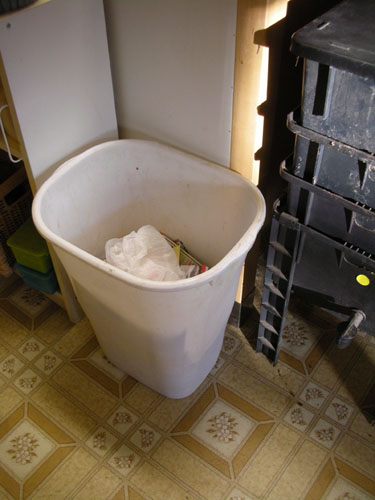
So we try to minimize the stuff that goes in the recycling bin, too (our city uses a combined bin for recyclables, so we don't sort). I use cardboard in the garden for weed suppression, rather than buying a plastic product for the same task. Plastic containers from prescription drugs make good seed containers (though I'd prefer to just be able to take them back to the pharmacy for a refill; give us a couple more years of the current economic cycle and they may be open to that). Waste paper gets shredded and used as bedding for the worms. Waste paper that's not recyclable (used tissues, paper towels, and pizza boxes) gets composted.
Trash
And last of all, the trash. We have the smallest trash bin available from our city, a 20-gallon container (actually a 32-gallon container with a 20-gallon liner). We usually fill it up enough to put it out every other week. This is aided by not having children, of course, but we know people with small children who have similar trash output. Mostly the trash bin is filled with non-recyclable plastics and packaging that happens to contain lots of mixed materials (thus rendering it non-recyclable).
Our big source of trash is our house and our ongoing work on it. Once a year, usually, we get a 15-yard dumpster and fill it (often with the help of our neighbors) with construction debris. Much of this has been plaster, but lately we've been filling the dumpster with things like fake wood paneling. We get a 15-yard dumpster because that's the smallest size that allows construction debris. We could also pay a hauler to take away trash for us, but that turns out to be more expensive.
It's sobering to think that an entire year of concerted effort at reducing our trash output can be negated by one major project on the house. Consider that construction accounts for 40% of the waste stream in the US, and you can see that there's a lot of room for improvement there.
The main problem for me has been how to reduce the waste. Most of what we generate is either clearly unusable (plaster mess) or contaminated (woodwork with lead paint) or no longer used (wood lath). I think the next time we tear down a plaster wall, we will probably do something with the wood lath that is slightly more sustainable than throwing it away, but that's such a small part of the waste. Plaster is really not re-usable at all -- or if it is, I haven't found any use for it that makes sense, though I'm open to ideas. The old woodwork started out being poor quality and shreds when you remove it from the wall (but can't be stripped in place, for the most part, because of the type of paint that was used on it). We salvaged most of the salvageable bricks from the chimney and foundation (but many were damaged beyond repair). Most of our discards are being discarded because they are rotted or damaged, not just for kicks and giggles, and in general those things don't work in reuse very well.
The big exception is the fake wood paneling. I have yet to find anybody who wants it, but we can remove it mostly intact from the walls and it could, in theory, be re-used. Only nobody, and I mean nobody, wants it. And of course it's the one building material with the highest embodied energy, being made of plastic and wood fiber, and of recent origin. If anybody has any ideas for getting rid of the stuff that do not include using it anywhere in our house, and do not include the many reuse places that have rejected it (so far: Center for Creative Reuse, Urban Ore, Habitat for Humanity), let me know, because we have a whole room of the stuff left to go.
So that's our trash. We keep working on making less of it. What are you doing to reduce your trash? What else could we do?
Technorati Tags: compost, demolition, dumpster, lead paint
posted by ayse on 11/25/08